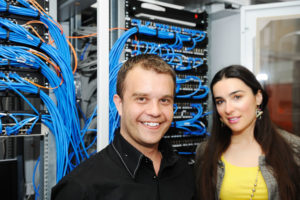It’s that time again when almost every attendee part of the annual EDUCAUSE conference crams next to each other in a convention ballroom to hear about what their higher ed peers have to say about the IT issues and challenges they expect to face next year.
“EDUCAUSE’s annual IT issues report is published in January, but this session provides a great preview of what’s to come,” said Michele Norin, senior vice president and chief information officer at Rutgers, the State University of New Jersey. Attendees were granted an exclusive preview of ‘2017’s Top 10 IT Issues,’ and panel members discussed the issues and their importance. [Editor’s note: See the 2016 issues here.]
According to Susan Grajek, vice president of data, research, and analytics for EDUCAUSE, there were three new issues mentioned by higher ed panelists this year: strategic leadership, higher education affordability, and next-generation enterprise IT.
The Top 10 IT issues for 2017
1. Information security: Developing a holistic, agile approach to reducing institutional exposure to information security threats.
2. Student success and completion: Effectively applying data and predictive analytics to improve student success and completion.
3. Data-informed decision-making: Ensuring that business intelligence, reporting, and analytics are relevant, convenient, and used by administrators, faculty, and students.
4. Strategic leadership: Repositioning or reinforcing the role of IT leadership as a strategic partner with institutional leadership.
5. Sustainable funding: Developing IT funding models that sustain core services, support innovation, and facilitate growth.
(Next page: IT issues 6-10; an in-depth look at next-gen enterprise IT)
6. Data management and governance: Improving the management of institutional data through data standards, integration, protection, and governance.
7. Higher education affordability: Prioritizing IT investments and resources in the context of increasing demand and limited resources.
8. Sustainable staffing: Ensuring adequate staffing capacity and staff retention as budgets shrink or remain flat and as external competition grows.
9. Next-gen enterprise IT: Developing and implementing enterprise IT applications, architecture, and sourcing strategies to achieve agility, scalability, cost-effectiveness and effective analytics.
10. Digital transformation of learning: Collaborating with faculty and academic leadership to apply technology to teaching and learning in ways that reflect innovations in pedagogy and the institutional mission.
When attendees were live-polled to see which of the 10 IT issues they’d like panelists to discuss the most, next-gen enterprise IT was the top issue.
“It really is a massive issue to consider, since it encompasses so many questions,” explained Gerard Au, associate vice president of IT services at California State University, San Bernardino. “It includes questions like how will everything integrate together? How will IT manage every component? How will we manage the supply chain? What is the university exit strategy when we have to switch from one system to another? Total cost of ownership is a critical metric to consider when discussing enterprise IT.”
According to Norin, agility is also a key issue associated with next-gen enterprise IT. “If you can confidently say that you can manage enterprise IT with agility, you’re one of a very fortunate few.”
“Agility, or at least lessening the burden of managing enterprise IT comes in having the foresight to map processes prior to implementation,” emphasized John Landers, project management office leader for Case Western Reserve University. “We have an entire team dedicated to business processes like these.”
The Digital Transformation of Learning
The second IT issue attendees wanted to discuss was the digital transformation of learning, which Rebecca Davis, director of instructional and emerging technology at St. Edward’s University, explained means an entire emerging ecosystem.
“A digital transformation affects the entire campus culture. All too often we think digital transformation just means content delivery online,” she said. “But we need to think about it as an ecosystem of networks, use of personalized data, and so many other components.”
“This ‘digital transformation’ is a big buzzword in higher ed right now, but what does it really mean,” asked Marden Paul, director of planning, governance, assessment & comms at the University of Toronto. “It’s a merger between culture and technology. You change not only content, but the roles of faculty, entire delivery mechanisms for learning, and how people engage in learning and with each other.”
For more information on EDUCAUSE’s 2017 IT issues, be sure to check the EDUCAUSE website and news in January 2017. For more information on the conference, click here.
- 25 education trends for 2018 - January 1, 2018
- IT #1: 6 essential technologies on the higher ed horizon - December 27, 2017
- #3: 3 big ways today’s college students are different from just a decade ago - December 27, 2017

